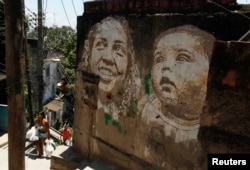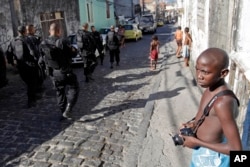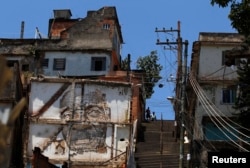Perched on a hill beside the skyscrapers of Rio's business district stands the city's oldest informal community, whose rising — and now declining — fortunes mirror those of Brazil itself.
Established by landless veterans fresh from putting down an uprising in northeastern Brazil in 1897, Morro da Providencia is considered Rio's first informal settlement, or favela.
Most residents of the working-class community of narrow streets and small, colorful buildings do not have deeds to their homes.
A lack of formal property ownership, however, did not hinder about 4,000 inhabitants of the bustling settlement from improving their lives as Brazil's economy boomed in the first decade of the 21st century.
"Things were getting better. There were some changes with [improved] sanitation and pavements," Gisele Dias, a community leader in Providencia, told the Thomson Reuters Foundation.
"But now it's getting worse here," she said during an interview in her small office at the base of the neighborhood.
Lure of a better life
Poor European immigrants, veterans and waves of migrants from Brazil's poorer northeast poured into communities like Providencia through the mid-1900s, looking for work and a better life in Rio.
Unlike other favelas, which were destroyed in the 1960s and '70s during Brazil's military dictatorship, Providencia was spared. Its residents were important for the local economy, because they provided a crucial labor source for Rio's bustling shipping docks, Porto Maravilha, and other central businesses.
Despite its role building the city's wealth, the community did not receive formal connection to the Rio power grid until the 1980s.
Boom to bust
Today, Providencia has been hit particularly hard by Brazil's recession, the nation's worst since the 1930s.
Many residents lost their jobs as laborers around the central business district or in other parts of Brazil's second-largest city, community members said. To make matters worse, the state government of Rio, responsible for some services in Providencia and other favelas, is essentially broke and has been unable to pay its debts.
Over the last five years, Rio has accumulated billions of dollars in government-backed loans to pay for infrastructure ahead of the 2014 World Cup and 2016 Olympics. But like several other Brazilian states, Rio is unable to pay back the money as the recession drags down tax income and oil royalties.
Promised upgrades to infrastructure in favelas across Rio have been abandoned, and existing public services are at breaking point, residents said.
"Police and firemen aren't getting paid," said Dias. "Many government offices are closed."
Poor 'feel it first'
Providencia's declining fortunes are no surprise to Mariana Dias Simpson, a researcher on urban issues with the Brazilian Institute for Social and Economic Analysis (IBASE), a Rio de Janeiro nonprofit organization.
"People had seen a large improvement in quality of life over the past 10 years ... they could get jobs and security was improving," Simpson told the Thomson Reuters Foundation. "But in the past two years, things have been getting worse again. The poor are the ones who feel it first."
Security, in particular, has declined in the community, say residents. Located near key venues for the 2016 Olympics, Providencia benefited from some of the 85,000 security personnel deployed to protect the games.
Since the Olympics, however, those officers have been pulled off the street amid budget shortfalls as increasingly desperate people turn to crime.
"There have been many shootings lately," said local resident Miro Lopez. "This is the first favela in Rio, and it's getting worse."
New infrastructure
Brazil's authorities launched a series of major infrastructure projects during the boom years in a bid to improve conditions in informal communities and create jobs.
According to data from the Ministry of Finance, nearly $1 trillion has been poured into infrastructure and other public investment under the Growth Acceleration Plan (PAC) since 2007.
The favelas, home to more than 20 percent of the city's population, received upgrades to their transportation links and other services as part of this wave of public spending before the recession, said an official from the Rio state government.
"Residents of the slums believed their lives could change with the improvements from the PAC program," Ruth Jurberg, a senior official from Rio's state government, told the Thomson Reuters Foundation.
Providencia also benefited specifically from other spending programs backed by the city of Rio, said community leader Dias.
In 2015, the government invested in construction of a new cable car for Providencia, saving residents a long trek up the hill to their homes.
"I take the cable car everyday; everyone likes it," said Andrea Sosa, a longtime resident of Providencia who works as a cleaner in central Rio. "To walk down, it would take 20 minutes, and it's dangerous."
More pressing needs
Other residents, however, say government spending has focused on splashy, big-ticket items like the cable car, ignoring more pressing if less glamorous needs.
Some homes in Providencia still lack connections to city sewage or water systems, residents say.
"It's easier to build a cable car than basic sanitation," said Simpson, the researcher. "From the beginning, they [officials] were not listening to the population."
Regardless of what specific infrastructure residents want, crucial investment in favelas has stalled because of "budget cuts," said Jurberg.
"There is a real threat to the gains made during the last nine years," the government official said.
















